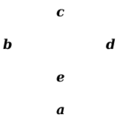English Rounders, 1828
from The Boy's Own Book, by William Clarke, 2d ed., (London: Vizetelly, Branston, 1828).
In the west of England this is one of the most favourite sports with the bat and ball. In the metropolis, boys play a game very similar to it, called Feeder. In Rounders, the players divide into two equal parties, and chance decides which shall have first innings. Four stones or posts are placed from twelve to twenty yards asunder, as a, b, c, d, in the margin; another is put at e; one of the party which is out, who is called the pecker or feeder, places himself at e.
He tosses the ball gently toward a, on the right of which one of the in party places himself, and strikes the ball, if possible, with the bat. If he miss three times, or if the ball, when struck, fall behind a, or is caught by any of the out players, who are all scattered about the field except one who stands behind a, he is out, and another takes his place. If none of these events take place, on striking the ball he drops the bat, and runs toward b, or, if he can, to c, d, or even to a again. If, however, the feeder, or any of the out players who may happen to have the ball, strike him with it in his progress from a to b, b to c, c to d, or d to a, he is out. Supposing he can only get to b, one of his partners takes the bat, and strikes at the ball in turn; while the ball is passing from the feeder to a, if it be missed, or after it is struck, the first player gets to the next or a further goal, if possible, without being struck. If he can only get to c, or d, the second runs to b only, or c, as the case may be, and a third player begins; as they get home, that is to a, they play at the ball in rotation, until they all get out; then, of course, the out players take their places.

